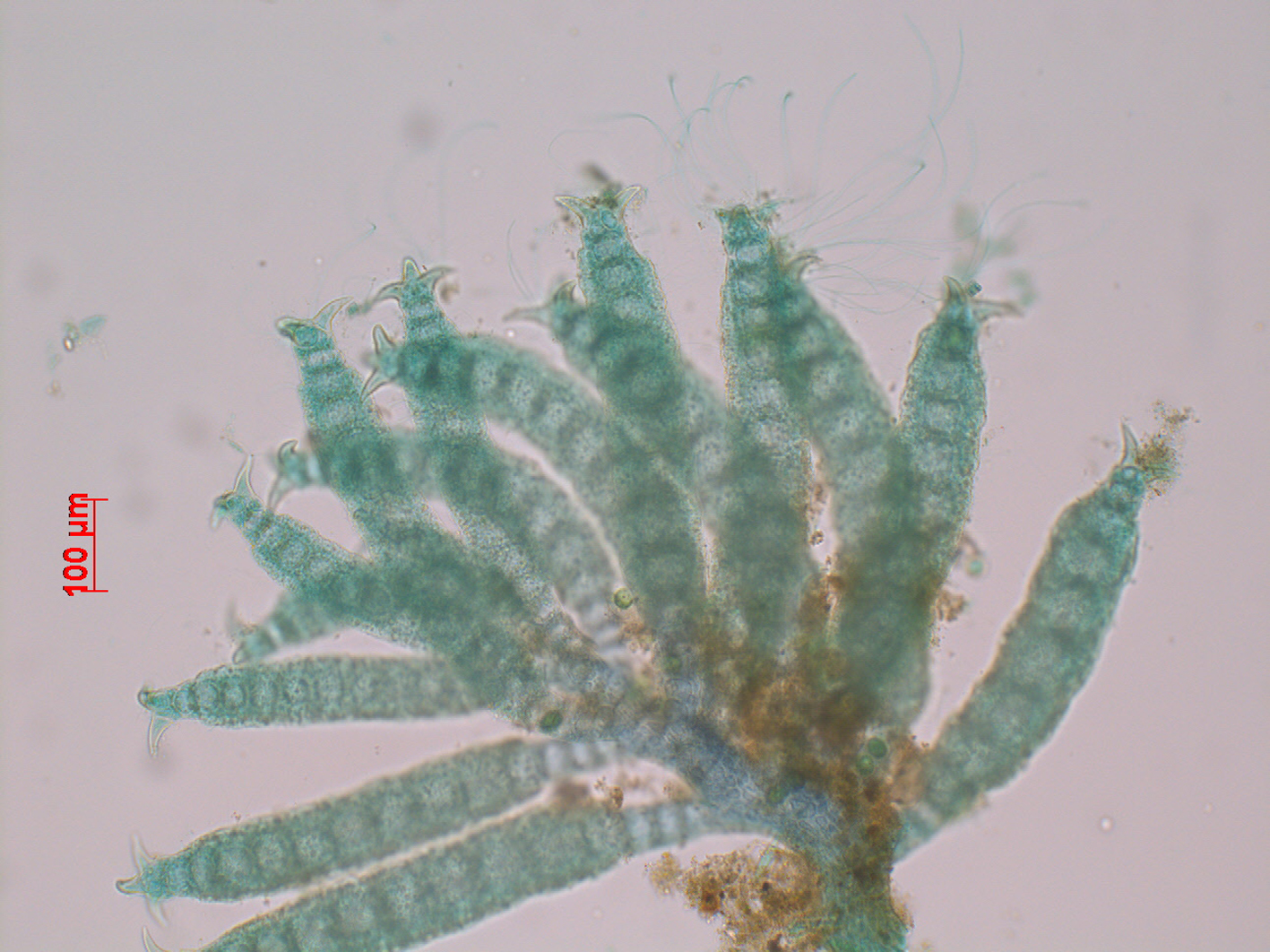Seaweeds of the South African South Coast


Order Ceramiales
Family Spyridiaceae
Spyridia cupressina Kützing 1849: 668
Plants bushy, up to about 20 cm tall, irregularly branched, with evenly-spaced hooked branchlets in four rows. Axes rigid, with a central filament of large cells (about as long as broad) surrounded by ca. 16 periaxial cells, each of which produces two cells in basipetal direction that connect with the periaxials of the central cell below. Secondary cortication present at a very short distance below the thallus apex, obscuring the primary structure. In cross section the central axes nearly square, with about five layers of progressively smaller cells surrounding the central cell. Each central cell with a determinate branchlet of 12-16 cells, with complete cortication, and three terminal spines. Spines somewhat recurved. Main axes about 0.5 mm in cross section, determinate laterals to 2 mm long and 350 µm in diameter basally, gradually tapering to the apex. Determinate laterals usually in four rows but sometimes almost distichous. Indeterminate branches at intervals of several segments, replacing determinate branchlets.
Tetrasporangia on much smaller branches that appear to be adventitious on the axes of the plant. The fertile shoot systems are ca. 800 µm at maximum, the individual ramuli much shorter, the cortication is incomplete, often consisting of a single ring of cells. Tetrasporangia scattered on the branchlets, fully exposed, tetrahedrally divided and measuring ca. 75 µm in cross section. Spermatangia on identical small shoots, covering the segments completely, the basal four segments without spermatangia and with incomplete cortication. Carposporophytes usually enclosed in two ostiolate lobes ca. 600 µm in diameter, on a normal determinate lateral, subtended by a few small shoots with incomplete cortication. Carpospores ca. 37 µm in diameter.
Collections, ecology and regional distribution
Although records indicate a distribution from Cape Agulhas to the north of KwaZulu-Natal (22-58), De Clerck et al. (2005) consider this species to be restricted to the Eastern Cape coast and southern KwaZulu-Natal, where it is fairly common (see note).
World distribution: Otherwise reported from Kenya and Madagascar, but these records are questioned by De Clerck et al. (2005).
Type locality: Cape of Good Hope, South Africa (Silva et al. 1996).
Note: De Clerck et al. (2005) point out that this species can be confused with the tropical species Phacelocarpus tristichus, but the latter has a different anatomy and branchlets that are in three rather than four rows.

Spyridia cupressina, Glen Muir (near East London).

Spyridia cupressina, thallus tips.

Spyridia cupressina, thallus tips, showing banding on laterals.

Spyridia cupressina, cross section (stained slide).

Spyridia cupressina, cross section through axis and determinate laterals (stained slide).

Spyridia cupressina, male adventitious branchlets (stained slide).

Spyridia cupressina, tetraspore-bearing adventitious branchlets (stained slide).

Spyridia cupressina, cystocarps and released carpospores (stained slide).
References Spyridia cupressina
De Clerck, O, Tronchin, E. M., Schils, T. 2005. Red algae. In: De Clerck, O., J.J. Bolton, R. J. Anderson and E. Coppejans, 2005. Guide to the Seaweeds of Kwazulu-Natal. National Botanic Garden of Belgium, Brussels (Scripta Botanica Belgica), pp. 130-269.
Kützing, F.T. 1849. Species algarum. pp. [i]-vi, [1]-922. Lipsiae [Leipzig]: F.A. Brockhaus.
Silva, P.C., Basson, P.W. & Moe, R.L. (1996). Catalogue of the benthic marine algae of the Indian Ocean. University of California Publications in Botany 79: 1-1259.
Cite this record as:
Anderson RJ, Stegenga H, Bolton JJ. 2016. Seaweeds of the South African South Coast.
World Wide Web electronic publication, University of Cape Town, http://southafrseaweeds.uct.ac.za; Accessed on 07 January 2026.